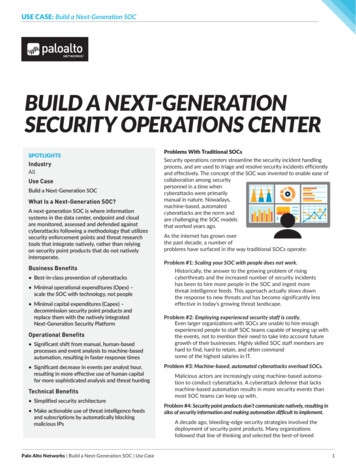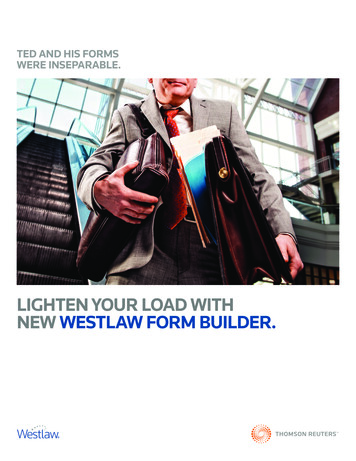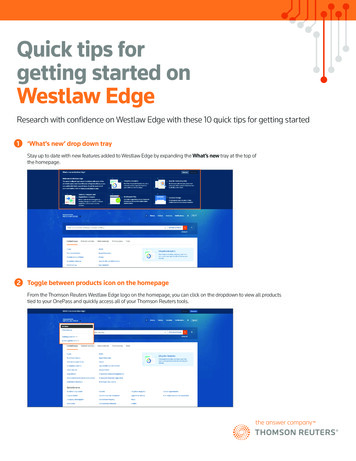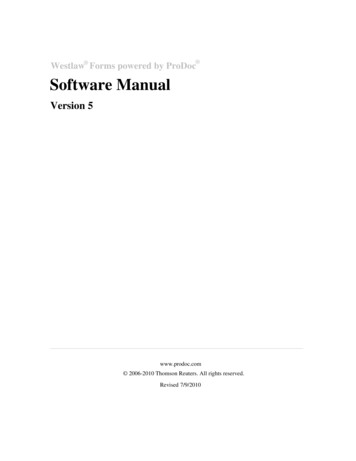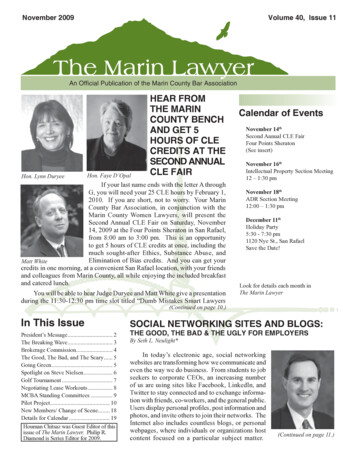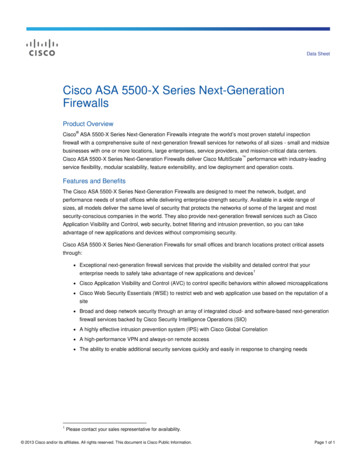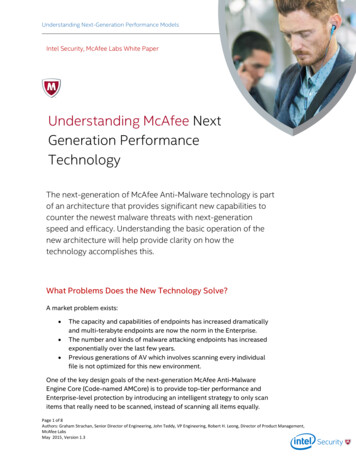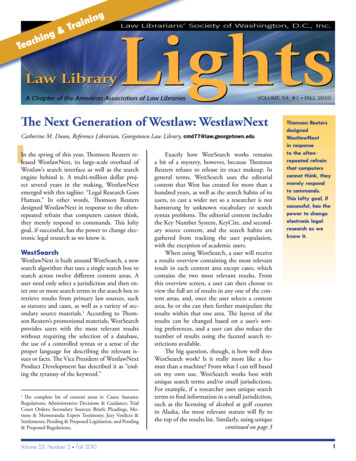
Transcription
rainTg&nichTeaingThe Next Generation of Westlaw: WestlawNextCatherine M. Dunn, Reference Librarian, Georgetown Law Library, cmd77@law.georgetown.eduIIn the spring of this year, Thomson Reuters released WestlawNext, its large-scale overhaul ofWestlaw’s search interface as well as the searchengine behind it. A multi-million dollar project several years in the making, WestlawNextemerged with this tagline: “Legal Research GoesHuman.” In other words, Thomson Reutersdesigned WestlawNext in response to the oftenrepeated refrain that computers cannot think,they merely respond to commands. This loftygoal, if successful, has the power to change electronic legal research as we know it.WestSearchWestlawNext is built around WestSearch, a newsearch algorithm that uses a single search box tosearch across twelve different content areas. Auser need only select a jurisdiction and then enter one or more search terms in the search box toretrieve results from primary law sources, suchas statutes and cases, as well as a variety of secondary source materials.1 According to Thomson Reuters’s promotional materials, WestSearchprovides users with the most relevant resultswithout requiring the selection of a database,the use of a controlled syntax or a sense of theproper language for describing the relevant issues or facts. The Vice President of WestlawNextProduct Development has described it as “ending the tyranny of the keyword.”The complete list of content areas is: Cases; Statutes;Regulations; Administrative Decisions & Guidance; TrialCourt Orders; Secondary Sources; Briefs; Pleadings, Motions & Memoranda; Expert Testimony; Jury Verdicts &Settlements; Pending & Proposed Legislation; and Pending& Proposed Regulations.1Volume 53, Number 5 Fall 2010Exactly how WestSearch works remainsa bit of a mystery, however, because ThomsonReuters refuses to release its exact makeup. Ingeneral terms, WestSearch uses the editorialcontent that West has created for more than ahundred years, as well as the search habits of itsusers, to cast a wider net so a researcher is nothamstrung by unknown vocabulary or searchsyntax problems. The editorial content includesthe Key Number System, KeyCite, and secondary source content, and the search habits aregathered from tracking the user population,with the exception of academic users.When using WestSearch, a user will receivea results overview containing the most relevantresult in each content area except cases, whichcontains the two most relevant results. Fromthis overview screen, a user can then choose toview the full set of results in any one of the content areas, and, once the user selects a contentarea, he or she can then further manipulate theresults within that one area. The layout of theresults can be changed based on a user’s sorting preferences, and a user can also reduce thenumber of results using the faceted search restrictions available.The big question, though, is how well doesWestSearch work? Is it really more like a human than a machine? From what I can tell basedon my own use, WestSearch works best withunique search terms and/or small jurisdictions.For example, if a researcher uses unique searchterms to find information in a small jurisdiction,such as the licensing of alcohol at golf coursesin Alaska, the most relevant statute will fly tothe top of the results list. Similarly, using uniquecontinued on page 3Thomson ReutersdesignedWestlawNextin responseto the oftenrepeated refrainthat computerscannot think, theymerely respondto commands.This lofty goal, ifsuccessful, has thepower to changeelectronic legalresearch as weknow it.1
FROM THE EDITORWelcome!Ripple L. Weistling, Reference & Electronic Services Librarian, American University, WashingtonCollege of Law, rweistling@wcl.american.eduWWelcome to the first issue of Volume 54 of LawLibrary Lights. The theme for this issue is teaching and training. As I have been putting this issue together, the academic year is in full swingand it is almost impossible for me not to havesome sort of teaching on my mind.I have been an academic reference librarianfor slightly more than four years now, and teaching was one of the main things that drew me tothis particular branch of librarianship. However,when I first started I looked forward to what wason my formal teaching schedule with a mixtureof anticipation and dread that I think is familiarto anyone who has ever made a living or even ahobby of standing in front of a group of peopleand sharing what you know. One of the thingsthat I looked forward to with rather more dreadthan anticipation was my shift at the referencedesk. I once told a colleague that sitting therefelt like taking a pop quiz every afternoon—acontinued on page 3LLSDCTable of ContentsFEATURESThe Next Generation of Westlaw:WestlawNextCatherine M. Dunn1Developing Effective Fact-Based LegalResearch Skills for New Associates, or“You Want Me to Research What?*Melanie Oberlin and Lucas Meyers6The Spy Who Came in from the StacksJanice Fridie11Reference Librarians: Teachingon the Move and Going GlobalTracy Woodward13Training Tools We LoveRicha Dasgupta and Aaron O’Brien14COLUMNSEditor’s ColumnRipple Weistling2President’s ColumnChristine Ciambella10AALL Annual Meeting10AALL News12Book ReviewDawn Bohls16Tech TalkRoger V. Skalbeck17Law Librarians’ Society of Washington, DCA Chapter of the American Association of Law LibrariesDeadline forSubmissionsIf you would like to write for Lights, contact RippleL. Weistling at rweistling@wcl.american.edu.For information regarding submission deadlines andissue themes, visit the LLSDC Web site at www.llsdc.org.Law Library Lights is published quarterly by the Law Librarians’ Society ofWashington, D.C., Inc. 20009, ISSN 0546-2483.Beginning with Vol. 50, #1 (Fall 2006), Law Library Lights is now published inPDF format on the LLSDC Web site: www.llsdc.org. Notification of availability of each new issue will be sent to the LLSDC listserv. If you would liketo receive individual e-mail notification when new issues are published, pleasesend an e-mail to Ripple L. Weistling at rweistling@wcl.american.edu.LLSDC does not assume any responsibility for the statements advanced bycontributors to Law Library Lights. The views expressed herein are those ofthe individual authors and do not constitute an endorsement by LLSDC.2LLSDCLaw Librarians’ Society of Washington, DCA Chapter of the American Association of Law LibrariesLaw Library Lights
From the Editor continued from page 2pop quiz designed by someone with a ridiculously wide range of interests and a warped senseof humor.It took me a while to warm up to that, and Ionly really did so once I realized that this was justanother mode of teaching. It wasn’t about knowing the answers but about seeing the questionsas an opportunity. People are most interestedin learning when they have something theyneed to know, so I find that much of my bestand most interesting teaching gets done in response to reference questions. It can be a littledisorganized and somewhat nerve wracking: Iam almost never in control of the agenda, andsome days I feel like a contestant in an oddlythemed game show. Imagine Alex Trebek announcing “Our first category today is The Legislative and Regulatory History of the CleanWater Act.” But as librarians know, this is a terrific way to reach people who are engaged withtheir material and interested in what you haveto teach them.So welcome to the teaching and training issue, where we try to capture some of what wehave learned about engaging with users andteaching them how to get the most out of ourresources. Catherine Dunn reports on WestWestlawNext continued from page 1search terms, such as the regulation of snowmobile use in Yellowstone National Park, WestSearch will retrieve very relevant regulations andother administrative materials even when usingthe broad “All Federal” jurisdiction.That said, though, every search using WestSearch seems to result in a few content areasthat absolutely miss the mark. In my two example searches above, the “most relevant” secondary source listed in the results overview didnot prove useful in either instance. In the Alaskasearch, the top result is an Alaska Law Reviewarticle that summarizes the important cases inthe state from 1993, none of which relate to thelicensing of alcohol at golf courses, and in theYellowstone search, the top result in the secondary sources category is an article on obtainingsurplus animals from certain national parks inFederal Procedure, Lawyer’s Edition. Considering the strength of Westlaw’s secondary sourceofferings as well as the popularity of ResultsPlus,seasoned researchers will expect better resultsVolume 54, Number 1 Fall 2010law Next, providing an overview of the newinterface and search algorithm, and where thenew version is better, or worse, than classicWestlaw. Melanie Oberlin and Lucas Meyersexplore teaching new law firm associates to dofact-based research; Janice Fridie writes aboutusing humor and a touch of drama to enlivenresearch workshops at the Department ofJustice Library. Richa Dasgupta and AaronO’Brien review remote training tools. And TracyWoodward describes the thrill of teaching lawstudents sophisticated uses of a familiar tooland of taking teaching and training way beyondthe law library.I would like to take this opportunity to welcome our new assistant editor, Jill Smith, andour new LLSDC President, Christine Ciambella. We also welcome back our columnists,Dawn Bohls, Shannon O’Connell, and RogerSkalbeck. In this issue, Dawn reviews TellingAin’t Training, which offers practical advice fordesigning a learner-centered approach to training, while Roger analyzes the tweets from the2010 AALL conference and describes optionsfor capturing, saving, and analyzing Twittercontent for any purpose.If you would like to be a part of Lights,please let me know. I welcome article ideas aswell as offers to write an article. LLLWelcome to theteaching andtraining issue,where we try tocapture some ofwhat we havelearned aboutengaging withusers and teachingthem how to getthe most out ofour resources.at the top of the secondary sources content areawhen using WestSearch.Although irrelevant results in WestSearchseem to be more prevalent in secondary sources, they appear in the context of primary lawmaterials as well. One such example is a searchfor “stalking” in the “All Federal” jurisdiction.The regulation and administrative decision on theWestSearch overview screen relate to celery andbroccoli respectively. (It is worth noting thatthe secondary source listed on the overviewscreen fares little better. It is about acting as astalking horse bidder.) When compared totraditional Westlaw, the regulatory search largelymirrors the type of results of a natural language search for “stalking” in the CFR, soWestSearch seems to add little, if anything,beyond a pure relevancy search. Using eitherterms and connectors searching or the RegulationsPlus Index to the CFR, on the other hand, retrieves results relating to or otherwise referencingcriminal stalking.continued on page 43
Thomson Reutersis trying differentpricing options,but at this pointWestlawNextis basically anadd-on servicethat chargeslargely based onthe retrieval ofdocuments, whicha user can thencontinue accessingwithout incurringadditional costsfor a full year.WestlawNext continued from page 3The key points to take away from all of this,I believe, are that researchers who use WestSearch must have a strong understanding ofthe types of sources WestSearch encompasses inorder to effectively manage their results, and researchers must still critically assess, limit, and rework searches when using WestSearch. This mayseem obvious to information professionals, butI fear that it is a distinction that may be lost onthose members of the Google generation whoare fairly new to research, such as law studentsor new graduates. In fact, the very first presentation I attended on WestlawNext this past springhighlighted Westlaw data showing that manyusers expect to find their best material in thefirst three to five results and often will not lookbeyond that set of results. As such, the ProductDeveloper who presented stated that they deliberately designed WestSearch to align with thisstyle of research. Under such circumstances, itis hard to fault new researchers who stronglygravitate toward single search boxes for failing tounderstand what the content in the results overview is/means or that WestSearch results mustbe carefully assessed, limited, and reworked toprovide meaningful research results.Other Search Tools on WestlawNextIn an attempt to capture everything of valueto a user, WestSearch deliberately broadens aresearcher’s search results beyond traditionalkeyword searching through the use of extracontent, such as headnotes and user data. Thisresults in a loss of search precision, which isfurther compounded by the lack of transparency in searches done via WestSearch. As mentioned above, researchers can never be sure whatexactly WestSearch is using to compile the endsearch results, since that information is withheldfrom users as proprietary, so a researcher canoften struggle when trying either to analyzemissteps in a research path or to be sure thathis or her research is comprehensive. Sinceprecision and transparency can be so criticalfor practicing lawyers in their research, it isimportant to note that WestlawNext retainsmany of the search capabilities from traditionalWestlaw, which can help with both precisionand transparency.For example, users can still locate databasesor collections of materials from the main screenarea on WestlawNext and then run either plain4language or terms and connectors (Boolean)searches in the general search box. A plain language2 search will provide the same results asWestSearch, but in a single content area basedon the database the user chose, rather thanacross all twelve content areas. A terms andconnectors search, on the other hand, will override WestSearch and allow for the same level ofprecision as a terms and connectors search ontraditional Westlaw. The user must be familiarwith the connectors already, however, since thescreen does not have the same “cheat sheet” typeof information on terms and connectors as thesearch screen in individual databases on traditional Westlaw. Note, also, that a user need notbrowse from the main screen of WestlawNext toretrieve known databases. Instead, a user maybegin to type a database name or identifier intothe search box, and the system will bring up aseries of options as it works to guess the databasethe user seeks.Researchers who used field searching ontraditional Westlaw can still search by field onWestlawNext through the advanced search function. After selecting a specific database, a usermust select the “advanced” link to the right ofthe main search button. The search screen thatappears will have a series of boxes representingthe available search fields for that database, soa user can simply fill in the available boxes asappropriate to craft the search. As above withtraditional terms and connectors searching, using these fields overrides WestSearch and allowsfor increased precision in searching.A user can also still find materials by citation in WestlawNext. To find something usingits citation, a user need only type that citationinto the main search box. Assuming the citationis in a form that can be read by WestlawNext,the system will retrieve that document regardlesswhat the jurisdiction selection happens to be.Finally, finding aids such as indexes, tablesof contents, citators (KeyCite), and the headnote system (Key Numbers) continue to beavailable on WestlawNext as well, although notalways with the exact same functionality as ontraditional Westlaw. One example of reducedfunctionality is the fact that a user cannot limit aKeyCite display across multiple content areas onNote that plain language on WestlawNext is not the sameas natural language on traditional Westlaw (which does notexist on the WestlawNext platform). According to representatives of Thomson Reuters, they use different searchalgorithms, although both are relevancy-based searches.2Law Library Lights
WestlawNext. Unlike traditional Westlaw, wherea user can easily limit a set of citing references tojust cases and law journal articles, for instance,WestlawNext requires the user to select a contentarea from the full list of citing references beforehe or she can place any limits. Since cases andlaw journal articles fall in two different contentareas (the “cases” and “secondary sources” content areas), a user must add limits and review theresults for each type of material separately, whichis terribly inconvenient for a sophisticated user.WestlawNext’s Interface,Organizational Tools & PricingWhile WestSearch is the cornerstone of this newsystem, WestlawNext also introduces a brandnew interface and a series of organizational toolsthat were not present on traditional Westlaw.The new interface cleans up much of the clutter a user sees in traditional Westlaw, which is awelcome change. Sometimes it does so to a fault,such as in the headnotes of cases where a usercan no longer see the full KeyNumber hierarchywithout selecting it, but most of the time the newinterface is a vast improvement with clear pathsto the useful finding tools and editorial analysisWestlaw has always been built upon.In addition, WestlawNext introduces a series of organizational tools, including foldersfor saving full documents or selections fromdocuments. Users can also highlight portions ofdocuments and attach notes that will stay withthe document until the user decides otherwise.WestlawNext still allows for printing, downloading, and emailing, of course, but the new organizational system spurs users toward electronicanalysis and storage of materials. Practitionershave some concerns regarding the preservation ofwork-product privilege, since their notes wouldthen be stored on Thomson Reuters’s servers,but these organizational tools can still be valuable purely for sorting materials from a series ofprojects for possible later use.Lastly, I would be remiss if I didn’t addressthe pricing of WestlawNext, even though it isless of an immediate concern for academic subscribers than for law firms and practitioners.Thomson Reuters is trying different pricing options, but at this point WestlawNext is basicallyan add-on service that charges largely based onthe retrieval of documents, which a user can thencontinue accessing without incurring additionalcosts for a full year. This is a big change from thestraight transactional and hourly pricing schemesVolume 54, Number 1 Fall 2010of the past, and it involves a fair bit of frontloading the cost due to the continued access component. As a result, many firms are reluctant to useWestlawNext until they determine how much ofa premium they will have to pay for it, if they cancontinue to pass at least some of the cost on totheir clients, and exactly how WestlawNext willbenefit their practice. In the words of an attorneyin private practice whose firm participated in abeta test of Westlaw Next:I like the new layout and look, and I find itmuch easier to use and more intuitive. With thatsaid, the whiz-bang search engine that was supposed to come along with this did not seem towork any different than a natural language searchfrom the old system. I constantly received justas much irrelevant information as I did with theold natural language searches (which I never useanyway) and switched back to the Boolean connectors. I am not sure the higher price is worthit for a search engine that is advertised as providing greater performance but does not.Concluding ThoughtsWestlawNext is still very new, so only time willtell the impact it will have on legal research as weknow it. Ultimately, Thomson Reuters designedWestlawNext as a replacement for Westlaw, so itwill be the only available interface at some pointin the future. WestSearch in particular is a veryambitious change, and it has the potential tohave a monumental impact on legal research ifresearchers come to trust it as an effective, more“human” way of conducting digital research.In the meantime, it is important for thoseof us who are using WestlawNext and teachingothers to use it to emphasize the use of a varietyof search methods using the system. WestSearchmay be a suitable starting point for some researchprojects, but its breadth requires that we teachusers how to use the ordering and sorting features available, as well as how to engage in moreprecise research using some of the more conventional research techniques that are still availableon WestlawNext.Finally, current users must remember thatWestlawNext is incomplete. There is still a fairbit of content that needs to be migrated overfrom traditional Westlaw, which ThomsonReuters aims to complete by the end of 2011.If you notice strange results or otherwise havefeedback on the system, WestlawNext has an“Improve WestlawNext” link on the bottom ofevery screen for user feedback. LLL5
Developing Effective Fact-Based LegalResearch Skills for New Associates, or“You Want Me to Research What?”*Melanie Oberlin, Instructional Services Librarian, George Mason University Law Library,moberlin@gmu.edu, and Lucas Meyers, Formerly an associate at Skadden, Arps, Slate,Meagher & Flom LLP; now practicing law in Austin, TexasRRecent law school graduates are familiar withhow to research general legal issues, such asthe court’s interpretation of “scienter.” Anothertype of legal research exists, though, and thatis “fact-based” research. This type of research iscommonly the responsibility of new attorneys.In a fact-based research situation, the supervising attorney already knows what the law is onan issue, but he wants the junior attorney tofind a case, possessing a very specific fact pattern and procedural posture, that supports hisspecific argument. Or he may ask a new attorney to find a case that supports a sentence thathe wants to write in a brief. In both situations,the law does not drive the research so much asa particular fact pattern and holding stated ina particular way. Many junior attorneys are notcomfortable with these types of assignments because they were only taught how to research thelaw, not facts.Applying a “law-based” research approach toa fact-based research question may be inefficient.Headnotes and other research aids based on legal concepts will be of limited use. Instead, usingfull-text searches to find cases that are factuallysimilar will yield better results.This article seeks to provide a method fora junior attorney to follow to effectively researchfact-based questions. Specifically, the articleaddresses the differences between Booleanand natural language searching, what kindof results can be expected, the strengths andweaknesses of each, and how to apply themto fact-based research. While librarians maythink that young associates are familiar withadvanced Boolean connectors, anecdotal evidence indicates otherwise. Recently, a youngassociate learned to force the order of operations using parenthesis and exclaimed that thishad changed his life. This article can be used asa guide for young associates and for librariansworking with them.6Boolean, or Terms andConnectors, Method of SearchingA Boolean search is one where the researcher iscompletely in control of the equation, or algorithm, that drives the search. You express yourpreferences using Boolean terms and connectorslike “AND”, “OR”, “NOT”, “ATLEAST”, etc.The advantage of Boolean is that the termsand connectors allow a researcher to create a veryexact search once he knows the key search termsfor his subject. For example, a case about wiretapping and the Racketeer-Influenced CorruptOrganizations Act (RICO) can be searched using the following terms:Wiretapping AND RICOThe search results, however, may include casesabout wiretapping brought in the District Courtin Puerto Rico that have nothing to do with theRacketeer-Influenced Corrupt OrganizationsAct (RICO). In this case, the search could benarrowed, as follows:Wiretapping AND RICO ANDNOT “Puerto Rico”Putting a phrase in quotation marks ensures thatthe computer recognizes it as a unified phraserather than as words separated by AND or OR,and any search results will only return (or exclude) that phrase.Order of Operations andthe Powerful ParenthesisThe computer reads Boolean connectors according to a set of priorities established by thedatabase vendor. For example, OR is usuallyprocessed first (highest priority), and then connectors are processed from left to right. The order in which the connectors are processed affectsthe accuracy of results. Parentheses can force theLaw Library Lights
order of operations, that is, the order in whichthe computer processes the Boolean connectors.A good example is provided in the Westlaw helpguide. In this search, the researcher wants to finddocuments that have the word frisk (or frisked orfrisks) or a phrase along the lines of “search andseizure.” This can be expressed as:ument, e.g., party names, judge’s name, court,dissent, concurrence, HeadNotes, syllabus, references, byline, author, etc. In most cases, the system makes it easy to limit the terms to a particular field using a template or a drop down menu.The system will then automatically add the information to a terms and connectors search.Frisk! OR (search! /4 seiz!)Natural Language SearchingIn a natural language search, just as in a Boolean search, an algorithm drives the search. Thedifference is that with natural language searching the computer generates the algorithm anddetermines the relevant documents, not the researcher. In a Boolean search, all of the terms in aquery have to appear in the document accordingto the relationships specified. In a natural language search, not all of the terms must appear,and the researcher cannot specify the relationships between the terms.One advantage of a natural language searchis that the results are shown in order of relevancein legal databases like Westlaw and Lexis. Thedocument the computer determines is most relevant is the first document in the list of retrieveditems. In contrast, a Boolean search in Westlawor Lexis will show results in a pre-determined order, such as reverse chronological order. As thesuccess of Google demonstrates, a good algorithm saves time by returning the most relevantresults first. Factors that influence relevance according to the algorithm include: the number ofsearch terms appearing in the document, howmany times the terms are repeated, whether thesearch terms appear in a title or section title, andhow close search terms appear near each other inthe document.The natural language search offers anotheradvantage over Boolean when the researcher isunfamiliar with what terms or jargon relate tothe question or the proper way to state the legalconcept. Queries can be less precise because theresearcher is not specifically directing the relationship between the words.To maximize the results, it is best to modifythe initial natural language query to reflect previous searches. The modified query need not bereadable or sensible. It should have lots of synonyms and a lack of prepositions and conjunctions. In addition, it should not be too short. Aquery must be reasonably lengthy for the systemto apply the algorithm’s rules. For example, if thequestion is, “When is a covenant not to competecontinued on page 8Here, the researcher has told the computerthat “search” (or searched) and “seize” (or seizure) need to be within four words of each other.“Frisk” can be alone or anywhere in the document.Complex ConnectorsMost systems support complex Boolean connectors. Examples include specifying that words appear in the same paragraph: Wiretapping /pRICO , or in the same sentence: Wiretapping/s RICO . Complex connectors can also be usedto indicate that two words should be within acertain number of each other, as in ruth /2 ginsburg , so that the search returns Ruth Ginsburgand Ruth Bader Ginsburg, as well as Ginsburg,Ruth. Typing search 2 seizure specifies thatthe first word should precede the second by upto two words. Entering atleast20(RICO) requires that the word or phrase appear at least Xnumber of times (20 in this example).Fuzzy Searches, Truncationand Wild CardsSome search systems run fuzzy searches. A fuzzysearch is one where very closely related words areretrieved. For example, Westlaw and Lexis automatically retrieve both the plural and singular ofyour term and are case-insensitive. In a searchfor “damage,” the system also retrieves “damages.” In a search for “RICO,” the system alsofinds “Puerto Rico” (because rico appears in bothwhen disregarding upper and lower case).1 Mostlegal databases also allow the researcher to createa fuzzy search by using wild card or truncationsymbols, such as * and !, which stand in for onecharacter or many, respectively.Field SearchesLegal databases also allow researchers to search aparticular part (“field” or “segment”) of the doc1If needed, most systems allow disabling the automaticplurals and case insensitivity.Volume 54, Number 1 Fall 20107
“You Want Me to Research What?”continued from page 7enforceable?”, then the query might be: covenant compete “non-compete clause” “non-compete agreement” enforce enforceable restrainttrade reasonable elements . The query may ormay not be stated in the form of a question, andprepositions and conjunctions can be omitted.Common words such as if, when, where, why,how, and whether can also be eliminated.One last advantage of the natural languagesearch is that in some systems (Westlaw, for example) the researcher can skip through the results to the point in each document where thealgorithm found the best match. Going to the“best” paragraph or section in each documentallows the researcher to determine very quicklywhether the document is relevant.A major disadvantage of natural languagesearching is that it will always return a
leased WestlawNext, its large-scale overhaul of Westlaw's search interface as well as the search engine behind it. A multi-million dollar proj-ect several years in the making, WestlawNext emerged with this tagline: "Legal Research Goes Human." In other words, Thomson Reuters designed WestlawNext in response to the often-




